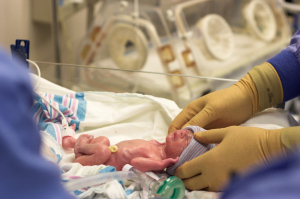Introduction
If a premature baby weighs less than 1500 grams (3 lbs. 5 oz.), there is a danger that the eyes will develop retinopathy of prematurity from prolonged exposure to high oxygen concentrations.
If a baby weighs less than 1000 grams (2 1/5 lb.) more than 80% of them will develop retinopathy of prematurity (ROP). This link shows several stages of severity of this condition. ROP develops as a result of prolonged exposure to pure oxygen (100%) that nurses administered in the past for breathing problems with premature babies. Studies have been undertaken to show that with lower concentrations of oxygen used in the crib, ROP and blindness can be prevented.
With ROP the normal development of the eye stops and an abnormal blood vessel growth occurs. Eye specialists and neonatologists are examining the eyes of premature babies in today’s high risk premature nurseries all the time. They watch very closely that oxygen concentration is not too high.
Signs and symptoms
Depending on how much new vascular growth the is, vision loss can occur more or less.
Diagnostic tests
These children need to be seen by an eye doctor on a frequent basis with ophthalmological examinations. These children are more prone to myopia, lazy eyes (amblyopia) and strabismus. With scarring in the retinal folds, the child is more prone later in life to have retinal detachments. Yearly examinations (even with a good outcome) must occur to prevent later problems.
Treatment
It has already been shown and it is being studied further how much early treatment of ROP benefits patients. Here is a link with other procedures such as cryotherapy surgery (cryopexy) or laser treatment to treat the excessive proliferation of blood vessels in an attempt to prevent retinal detachment and blindness later in life.
References
1. The Merck Manual: Retinopathy Of Prematurity (ROP).
2. Ferri: Ferri’s Clinical Advisor: Instant Diagnosis and Treatment, 2004 ed., Copyright © 2004 Mosby, Inc.
3. Rakel: Conn’s Current Therapy 2004, 56th ed., Copyright © 2004 Elsevier







